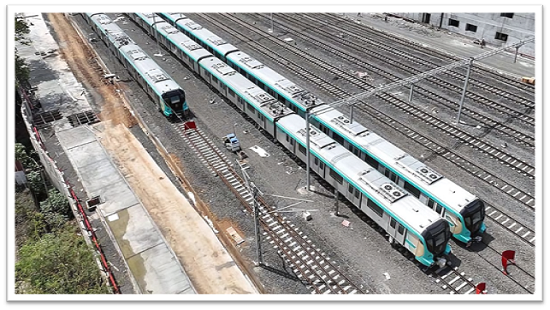
Mumbai Metro 3 Progress Update: Aqua Line Nears Full Completion, Transforming City Commuting
Mumbai is on the verge of a transformative shift in urban mobility with the Metro Line 3 Aqua Line, a 33.5-km fully underground corridor connecting Cuffe Parade in South Mumbai to Aarey in the western suburbs. More than a metro project, it represents a strategic rethink of how the city moves, works, and grows. For decades, Mumbai’s suburban railways and congested roads have struggled under increasing population pressure, and Metro 3 aims to change that narrative.
India’s first fully underground metro of this scale is designed to address capacity, connectivity, and commuter convenience simultaneously. By linking financial hubs, residential areas, hospitals, educational institutions, and cultural landmarks, the Aqua Line is poised to become the city’s circulatory system—streamlining daily commutes and unlocking economic potential.
The phased rollout reflects a methodical, governance-driven approach. The Aarey–BKC stretch has been operational since October 2024, BKC–Worli opened in May 2025, and the final Worli–Cuffe Parade segment now awaits fire safety clearance and CMRS inspection. Once fully operational, the corridor is expected to carry 4.5 lakh passengers daily, offering a faster, safer, and greener alternative to road transport, while marking a major milestone in Mumbai’s urban infrastructure journey.
Phase-Wise Rollout of Metro Line 3
The Aqua Line has been inaugurated in stages to ensure operational readiness and commuter adoption. The first operational stretch, from Aarey to BKC, became active on October 7, 2024, providing a direct lifeline to Mumbai’s emerging financial hub for western suburb commuters. The second segment, from BKC to Worli’s Acharya Atre Chowk, was inaugurated in May 2025, adding 10 km of connectivity and expanding access to South Mumbai. The final stretch, connecting Worli to Cuffe Parade, is awaiting fire safety clearance and CMRS inspection, which is the last step before full-scale operations.
This phased approach has allowed incremental testing, ridership adoption, and operational fine-tuning, ensuring a smooth commuter experience once the entire corridor opens.
Milestones Achieved
A major achievement came on July 23, 2025, when the entire Metro 3 track was energised with the 25 kV traction line, enabling trial runs on the remaining Worli–Cuffe Parade section. The corridor has already demonstrated strong ridership. As of August 28, 2025, the Aqua Line recorded over 1 crore passenger journeys across the operational segments from Aarey–BKC and BKC–Worli.
Once fully operational, Metro Line 3 is projected to carry 4.5 lakh passengers daily, scaling to 6.5 lakh trips over time, reflecting rapid adoption by commuters and highlighting the corridor’s role in alleviating pressure on suburban railways and congested roadways.
Strategic Impact on Mumbai’s Mobility
Metro Line 3 is not just a transport corridor; it is a strategic urban intervention. The project significantly cuts travel time between South Mumbai and the western suburbs, while offering direct rail access to both domestic and international airports—a long-standing demand of city commuters.
It also enhances last-mile connectivity to six major business districts, thirty office hubs, twelve educational institutions, eleven hospitals, ten transport nodes, and twenty-five cultural and religious sites. The corridor integrates seamlessly with the suburban rail networks at Churchgate and CSMT, while alleviating congestion on major road corridors such as the Western Express Highway.
Beyond these operational benefits, Metro Line 3 symbolizes visionary infrastructure planning, combining technology, safety, and urban strategy to deliver a world-class commuting solution.
Setting a Benchmark for the Future
Metro Line 3 demonstrates Mumbai’s commitment to sustainable, high-capacity, and commuter-centric urban transport. As India’s first fully underground metro at this scale, it serves as a benchmark for future projects in other megacities. With safety trials in their final phase, the corridor is on track to fully open soon, promising faster, greener, and more reliable commuting, and reshaping Mumbai’s mobility landscape for decades to come.




